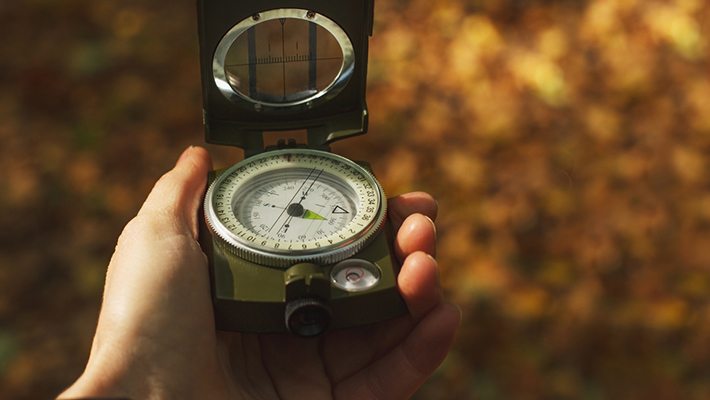When going to the wilderness, it’s important to know how to find your way in case you get lost.
Now, cellphones might help with their GPS, but only if you’re close to the urban area, but if you end up in a remote location, you have to rely on something that doesn’t require an internet connection.
Lensatic compass is something that every hiker should have. It’s something that soldiers rely on for many years.
Once you learn how to use a lensatic compass for beginners, all you will need is a map, and you will be your own GPS system.
More...
Types of Lensatic Compass

There are many versions of the compass, but the two types are considered as the most used ones, the lensatic, and the baseplate compass.
Both of them became widely used during the World War 2, but the Lensatic became the standard for the US Army, and it’s still today. You probably saw the soldiers using it in movies.
I will cover the details for the Lensatic compass since it’s more durable than baseplate, but the navigation concept applies to both of them.
The Lensatic compass is the most accurate when it comes to shooting azimuths.
Azimuth is the angle between the projected vector from the observer and the reference vector on the reference plane.
Parts of the Compass
The first time you look at the compass, it may seem that it’s a bit complicated with all of its markings and moving parts.
It seems like you need to be an expert to use it, but in fact, once you understand its principles it’s not that hard at all.
The main parts of the lensatic compass are the base, the reading lens, and the cover.
The cover is a lid with a sighting wire, the base is at the bottom half, and it has a floating dial with South, East, West, and North marked, with thumb loop and the bezel around it.
The dial points to the North, and it’s floating in usually some type of oil or kerosene.
The glass cover protects the dial, and the index line is engraved into it.
The reading lens is attached to the base in a moveable arm, and it folds to lay on the dial for protection.
Some parts are made to glow in the dark, so you can navigate in the dark.
Discover more:
1. The Ultimate Survival Gear List for all Thrill Seekers!
2. Hiking vs Trekking – What is the Difference Between Trekking and Hiking?
How to Hold Lensatic Compass Properly
The most important thing in understanding and using the lensatic compass is to use the right technique when holding it.
The improper holding can result in bad reading and leave you completely lost. The two main techniques are the centerhold technique and the compass-to-cheek.
The Centerhold
To execute this technique you need to open the compass to a full 180 degrees so that both the cover and the base can lie flat on the surface.
Next, fold the thumb loop until it’s fully opened and hold the compass with both of your hands in front of you.
Hold your elbows tight at the sides of your body and held the compass in front of your midsection.
Rotate your entire body to the target object while preserving the stance.
When you’re centered on the object look at the compass and write down the degree marked under the fixed index line.
The Compass-to-Cheek
The name itself of the technique says a lot. Open the cover to 90 degrees and the reading lens at 45.
Fold the thumb hook until it’s fully opened, and place your thumb inside the thumb hook.
Hold the compass as if you’re holding a gun with two hands.
Place the hand on your cheek so the index finger is in line with your nose and you can clearly see the lens.
How to Take the Bearing
Grab the compass with the grip you like. Locate the object you want to target, a mountain or some other high object to use for a bearing.
For centerhold technique, point the compass directly at the target, and for the compass-to-cheek, locate the target through the sighting wire, the wire should be centered on the target.
Hold the position, read the degree mark and take a note.
How to Navigate the Map

To navigate with a map, you will need a protractor, which is an instrument for angle measurement.
Take the map and mark the position you want to go to and your current position. Draw a line from your current position to the one you want to go to.
Take the protractor and put it on the map with the center point at your position, lining the north-south lines on the protractor with the ones on the map.
Then check where the line on the map intersects with the numbers on the protractor.
The number on the protractor which the line intersects is the number of degrees at which your direction should be.
Setting the Compass for Your Azimuth
- Hold it with the centerhold technique.
- Turn your body until the number of degrees you determined on the map is under the fixed black line.
- Don’t move or change direction, turn the compass housing until the short line is lined up with the magnetic arrow.
- And you’re set. To track your path, turn the compass around until the magnetic arrow lines up with the short line.
How to Shoot an Azimuth with Compass Sights
To shoot an Azimuth with Lensatic compass:
- Hold the compass with the compass-to-cheek technique.
- Turn your body until your Azimuth is lined with the fixed black line.
- Look through the sightings and find a target.
- Go to that target.
- Repeat until you arrive where you wanted.
More Important Things
Since compass uses magnetic energy to take a reading, it can be affected by magnetic and metal objects nearby.
Make sure you are not surrounded by them, so you have a clear and accurate reading.
The high tension power lines can also affect the reading, so make sure you are at least 50 yards away.
Check the compass dial before reading, it has to be able to move unobstructed, and the compass should not be damaged, in order to have an accurate reading.
Conclusion
The Lensatic compass is the best tool you can have to navigate through the wilderness. Now that you know how to use a lensatic compass make sure you have one with you when you’re uphill hiking, and bring the map of the local area, so you can navigate easily.
I hope this guidewas of help to you, and you managed to overcome what looked complicated at first glance.


